Grand Designs: Impressions of Soma's Low Trail Rando
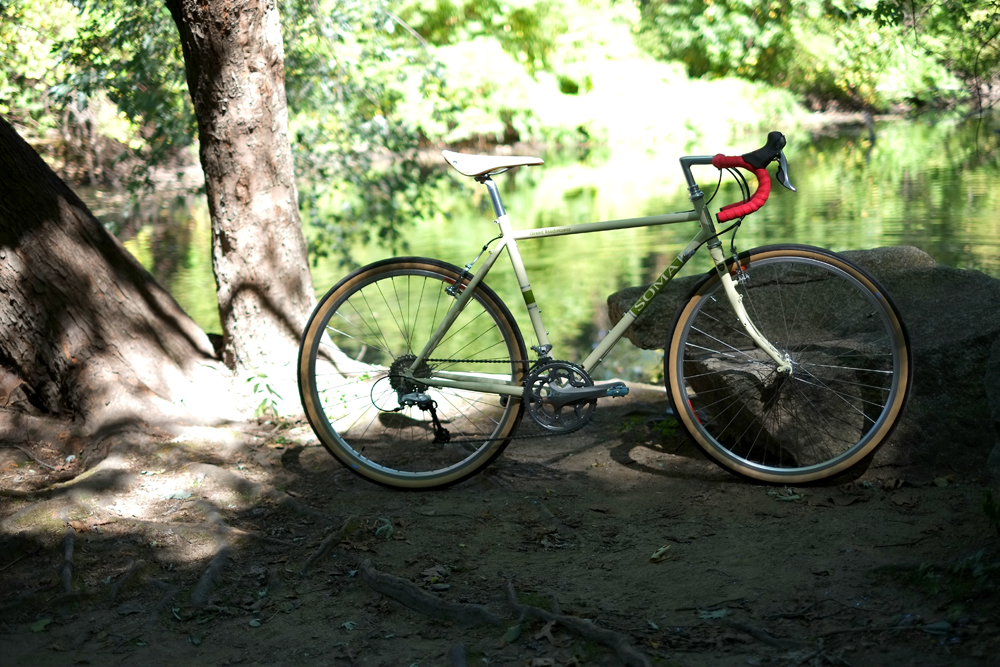
In the course of running this blog, I have come to notice some seasonal patterns in my readers' new bike acquisition tendencies. For instance, in late spring I get the most emails with questions about roadbikes, while interest in city bikes seems to peak in early Autumn. And smack in the middle of summer seems to be when desires for mixed terrain roadbikes, 650B rando bikes and the like, hit their all time high. With the warm weather no longer a novelty, no doubt the relentless heat and fierce sunshine drive folks into the woods - whereupon they discover a need for a dedicated bike for those lovely fire trails and gravel paths. In any case: Like clockwork, I have begun to receive emails pertaining to this topic. And among these is a recurring request to share my impressions of the Soma Grand Randonneur.
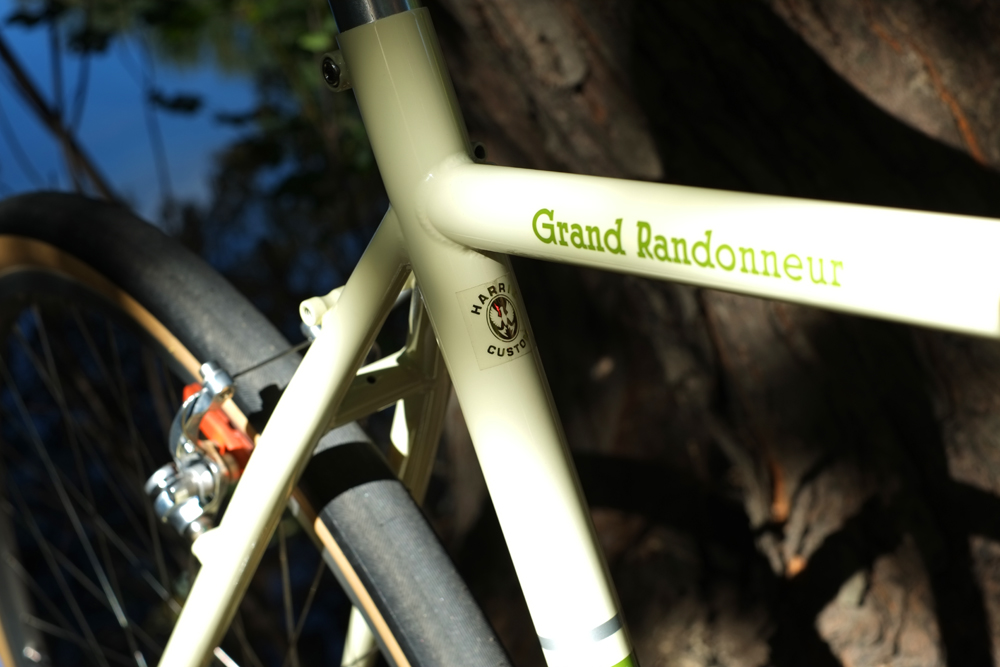
To provide some background: What seems like absolute ages ago now, and is certainly ancient history by internet standards, I "broke" the news of Soma's plans to offer a low trail 650B randonneuring model. The prospect of this was exciting, at least for those of us who care about that sort of thing, as at the time mass-produced and reasonably priced framesets of this type were an anomaly (and still are, for what it's worth).
So anyhow. I was meant to test ride the prototype of the Grand Randonneur when it became available. But by the time it did, it was summer 2013 and my life, as you may have noticed, went slightly haywire. Most bike-related plans I had at the time were put on the back burner or went out of the window entirely. And so the Grand Randonneur slipped my mind, until, on a visit back to Boston last Autumn, I saw it on display at Harris Cyclery. Looking ever so pretty in cream and green, it stood there shyly in the streaming morning light, shooting me a subtle but unmistakable come-hither glance. As it happened, the floor model was in more or less my size. And although the "cockpit" was not set up for me (normally I would use shorter-reach bars and/or stem and set the handlebars lower), we did our best in the time available to achieve a similar reach. Thereupon, I took the bicycle on a joyride through the local roads and woods for about an hour and a half.

The bicycle came fitted with Compass 650B x 38mm tyres - narrower than the 42mm Hetres I usually use on such bikes, but still wide and cushy,
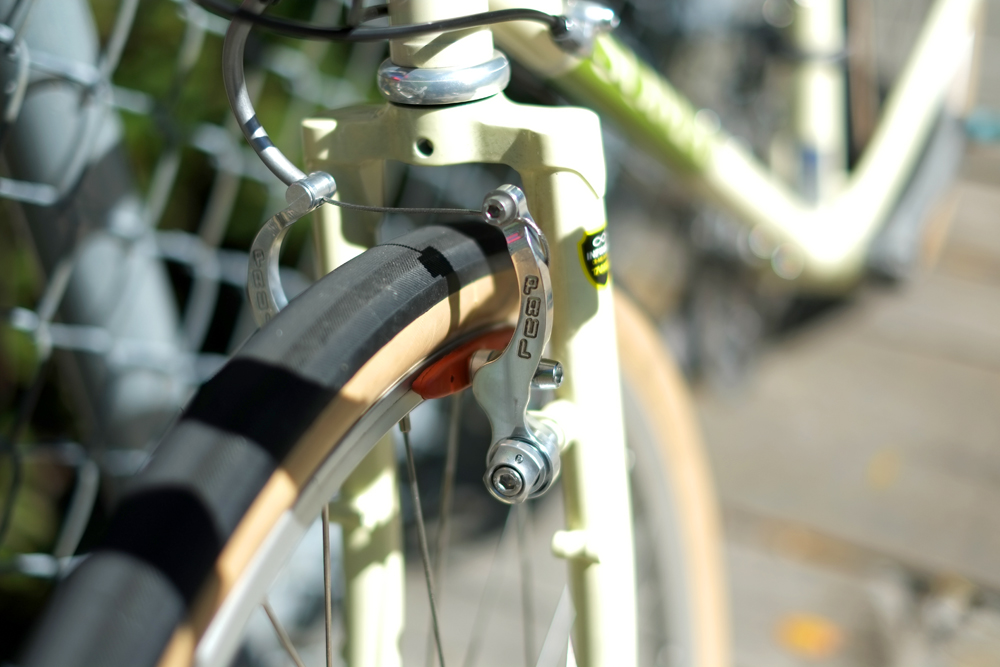
with the added benefit of having enough clearance for Paul's Mini-Moto brakes, which are wonderfully functional. Since the Grand Randonneur frameset is fitted with canti bosses, the choice is either cantilever or v-brakes (the latter being stronger, and therefore preferable to me). I am not sure whether any v-brakes currently on the market will clear 42mm tyres with fenders though.
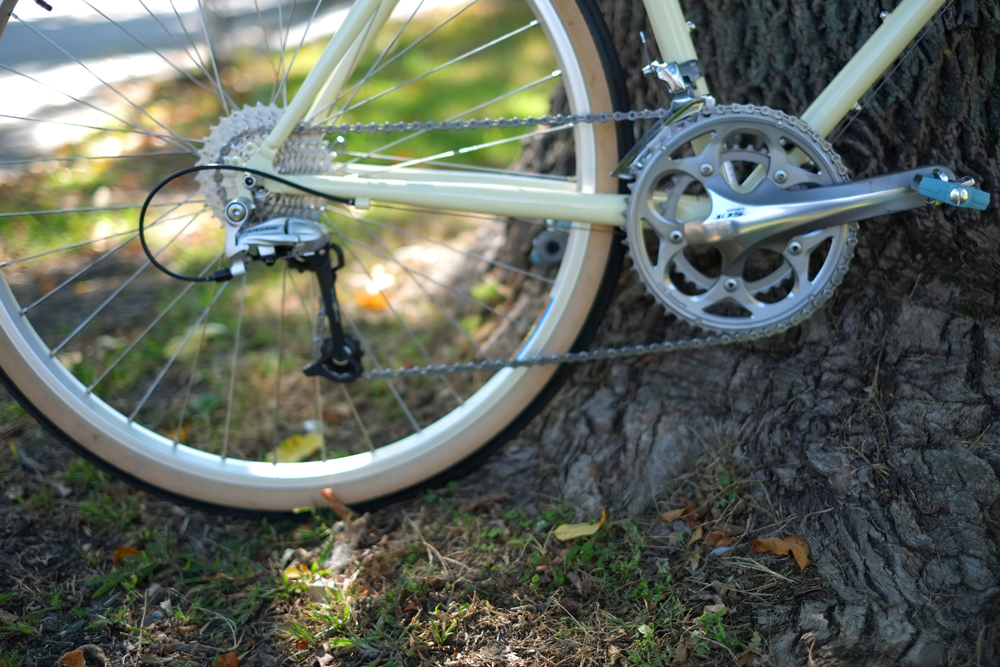
The Shimano 105 drivetrain felt nice and was geared fairly low, though owners of bicycles like this will typically want 1:1 or even sub-1:1 gearing.
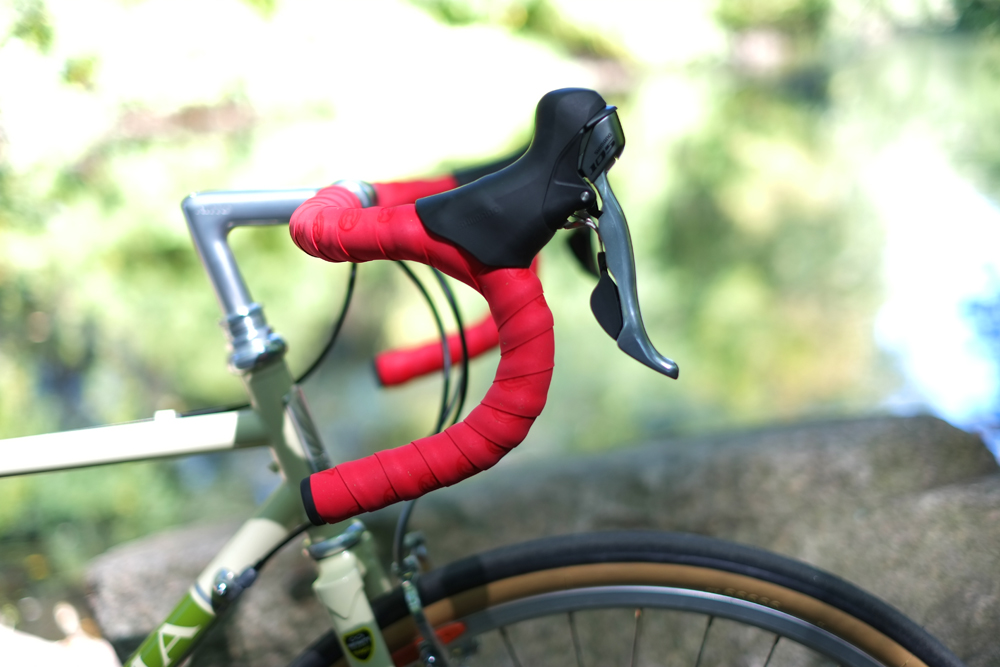
The Grand Bois Maes bars were comfy and familiar, with their lovely parallel drops.
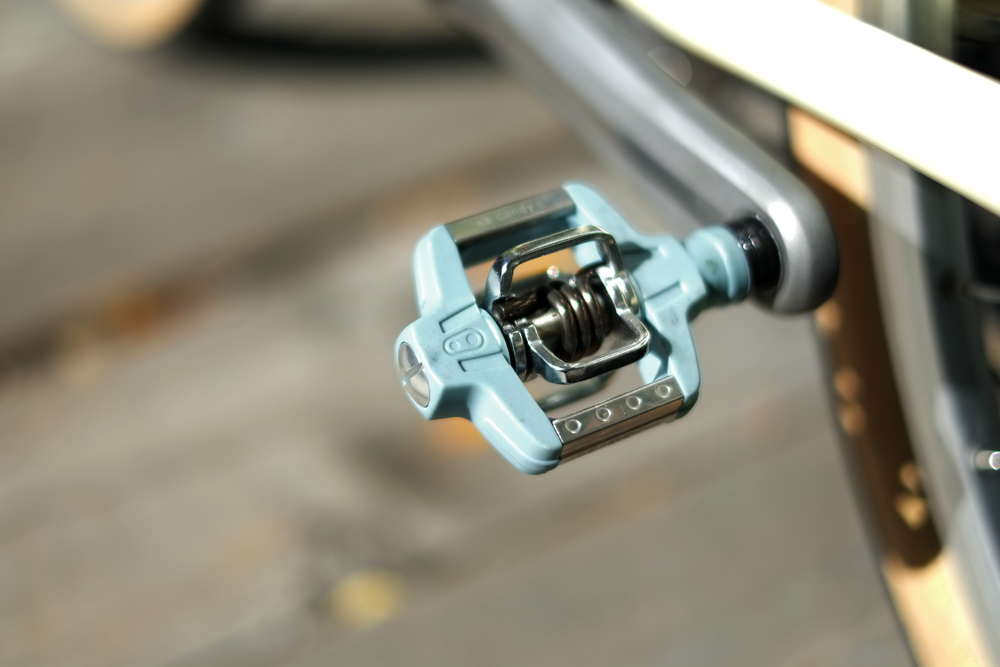
The NOS Crankbrothers Candy pedals a delicious treat, in this now-discontinued powder blue model.

And the Brooks Cambium C17 saddle was an excellent choice for demo and floor model bikes, as it needs no wearing in and feels comfortable from the get-go (I sport one of these on my own 650B bike and the looong-term review will be out soon).
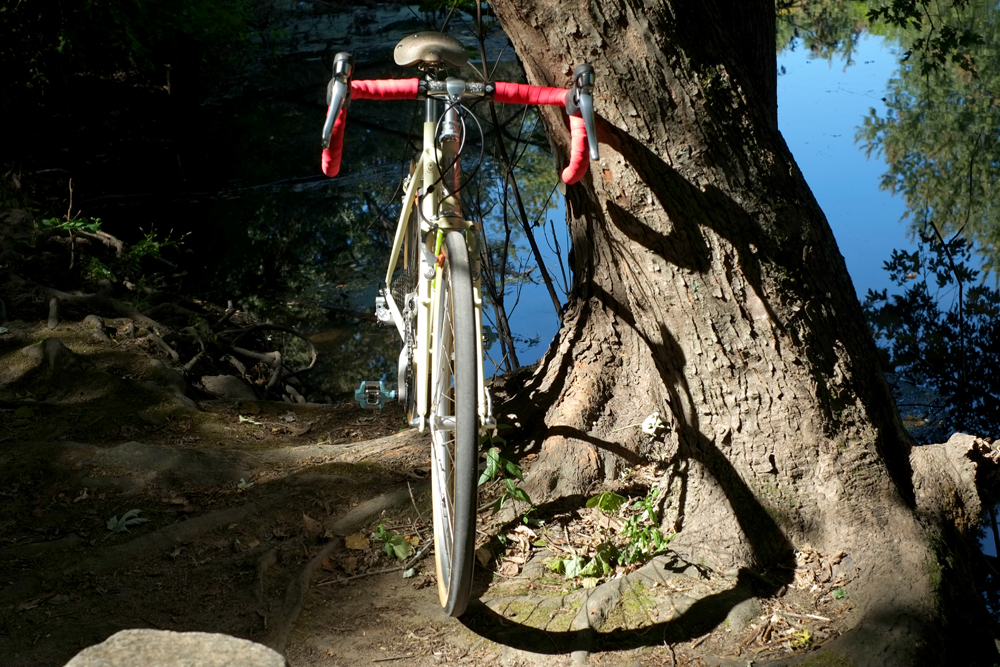
Of course, with the Grand Randonneur sold as a frameset, you can build it up with whichever components you like, barring some limitations. Notably absent here, but usually typical of a complete build for bicycles of this type are: fenders, front rack, handlebar bag, and lighting. The frameset of course comes with provisions for fenders and racks.
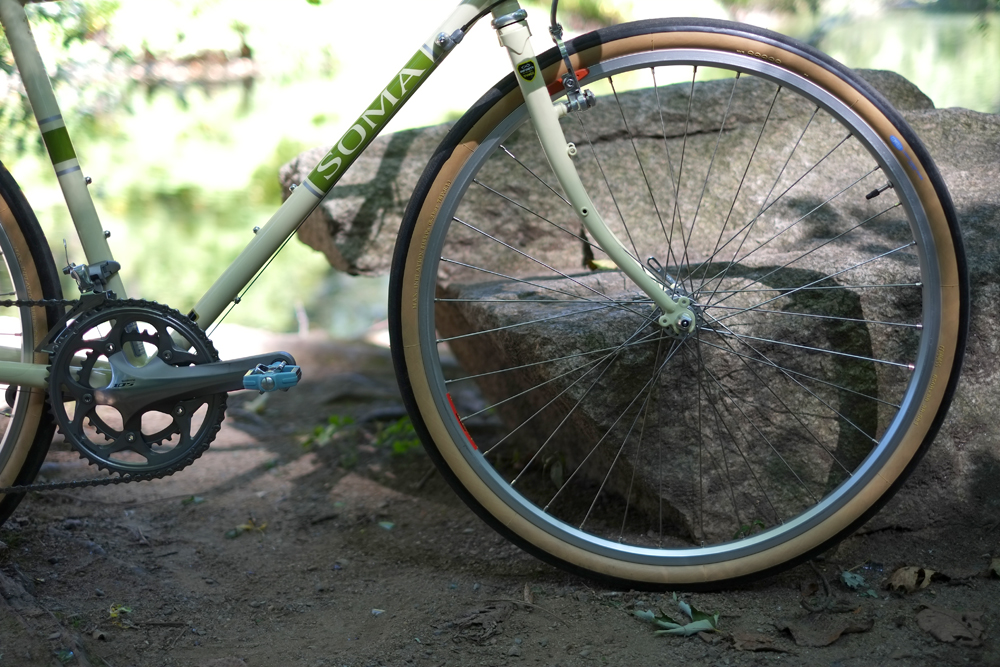
Described as a "a true low trail geometry randonneuring frame set," a distinguishing feature of the Soma Grand Randonneur is the raked-out fork. The trail varies, depending on frame size, from 29mm to 35mm - which is indeed proper low. And just look at all that sexy toe clearance!
While the Soma fork was bent in the "continuous curve" style rather than the more elegant "French flick", I can't say that I blame them: The latter method, as I know only too well myself, is trickier and more time consuming. The simpler bend also suits the overall utilitarian look of this bicycle: its welded construction (except for the brazed fork crown, thank god) and lack of ornamentation look accessible and unpretentious. Other notable aspects of the Grand Randonneur's geometry include a low bottom bracket and fairly short (considering the need for fat tyre clearance) chainstays. The range of sizes is pretty extensive (49.5 - 65cm) and you can view the complete geometry chart here (click on the Geometry tab - and note that in 2015 Soma has slightly tweaked this frame's geometry: increased frame stack by 15-20mm and reduced the seat tube extension).

So... As mentioned earlier, my test ride of this bicycle happened spontaneously. In fact, in my own little world here in rural Ireland over the past 2 years, I have been rather oblivious to the goings on of the bicycle industry and had not been following the Grand Randonneur project at all since its earlier stages. I did not know what to expect of the finished product. But my assumptions were, that, like the prototypical randonneuring bicycle of the type Jan Heine describes again and again so thoroughly in his publications, the Soma Grand Randonneur would (1) have low trail geometry with room for 650B x 42mm tires, and (2) be constructed out of lightweight, thin-wall, standard diameter steel tubing - for optimal "planing."

Riding this bicycle, it became immediately apparent that the first of these aspects was realised. Even without a front load, the Soma handled in the distinct manner I have come to expect of low trail bikes. There is a certain flavour, for lack of a better word, to low trail handling, and this bicycle has no shortage of it. As on other low trail bikes I own or have owned in the past, twisty tight forest trails were easier at high speeds, as was avoiding crater-sized potholes in traffic on fast descents, without losing control of the steering. In short, I will spare you the song and dance about the joys of low trail handling, except to say that this bicycle has it. What it didn't have however, was quite the same level of responsiveness to pedaling effort, or the same subtle pleasant flex, I'd grown used to in other machines of this category - including the Rawland Nordavinden on which I'd arrived to the bike shop. In fact, switching straight from the Nordavinden to the Grand Randonneur perhaps made for an unfairly cruel comparison: The former - even laden with fenders, wider tyres, a front rack, handlebar bag and dynamo lighting, had felt "lighter in motion" and springier in the fork than the pared-down machine I was now on.

I continued to ride the Grand Randonneur through suburb and forest, and indeed enjoyed it very much. It was great fun, sturdy, comfortable, attractive - just not a performance-oriented machine. And my feeling is, a lot of people were expecting a performance machine when Soma first announced the project.
My understanding of what happened, is that Soma ended up using thicker-walled tubing for the frame, and a beefier fork, than what those of us interested in the project had originally assumed would be used. And while my former contact at Soma is no longer there to give me the details, my understanding from others in the industry is that likely this was due to the pressure of safety regulations. In fact, current manufacturing standards may make it impossible to mass-produce a frame and fork to the exact specifications suggested by the Bicycle Quarterly folk - meaning that those who want a bicycle with 7-4-7 tubing and super lightweight fork blades, may have no option other than to go custom. And while the one exception to this (as far as I am aware) used to be the Rawland Nordavinden, notably that model is no longer produced, with the model which later replaced it (which, in turn, is also no longer produced!) sporting a heavier fork and stirring up great internet drama.

Be all that as it may, at $490 for the frameset, the Soma Grand Randonneur is a lovely, comparatively affordable low trail bicycle. If you enjoy the likes of the Soma ES, or the Surly Cross Check, and want something similar but with low trail handling, you will enjoy this bicycle very much. In my view, the Grand Randonneur is best suited for exploring, commuting, light touring, and many varieties of leisurely cycling. But if you are expecting a competition-oriented rando-bike that has tubing the thickness of tin foil and "planes" so exquisitely as to strike terror and admiration into the hearts of your ride companions, the Grand Randonneur ain't it. Know that about it in advance, and you won't be disappointed.
With thanks to Harris Cyclery for the test ride. Full picture set can be found here.

Haha, I can't help but wonder how much of that "drama" was fueled by me and the Jeff Lyon replacement fork group-buy that I coordinated. Given the $450 initial outlay for the Stag frameset and the additional $200 for a custom Jeff Lyon lightweight fork with Kaisei Special Oval blades and Grand Bois crown, for $650 the bike accomplishes both missions-- low trail handling and planing. https://www.flickr.com/photos/7516215@N03/17369318005
ReplyDeleteI think Soma took a lot of flack for the 1st generation Grand Randonneur, and are already working on version three. Isn't version two already available?
Oh I wouldn't worry, I think the internet is grateful to you for that project : ) Your bicycle looks great.
DeleteAs far as I know, the V2 consisted of the fairly minor tweaks I mentioned in the geo paragraph (increased frame stack and reduced the seat tube extension). Unless they are able to use different tubing and fork blades, I don't really see such changes making much difference.
Anyhow, I like Soma. I don't want to give them flack. But if people are expecting a budget Rene Herse with same ride characteristics (as I think many were, due to the Mike Kone collaboration) they need to know this isn't quite that.
A custom fork is a great option for making an otherwise not quite ideal bike into a bargain. It is also amazingly affordable if you shop around.
DeleteI had Joel Greenblat(I hope I remembered his name correctly, Stand-up Guy and a Craftsman) at Clockwork Bikes build a fork for my Mudhoney, I had quotes from $195 to $450 and waits of as long as 7 months. Clockwork delivered it in I think 3 weeks at $250. It wasn't a simple fork either as I wanted some specific things including what canti-mounts I wanted and forkends he didn't have on hand etc. Half the price of the carbon fork Seven would have supplied.
Somervillain, Your group-buy was an inspired idea. well done.
Spindizzy
Thanks! I think in the end somewhere around 25-30 went in on the Jeff Lyon fork deal, so it was a win for everyone-- for Stag owners and for Jeff (and for Compass Cycles, who supplied the fork blades and crowns).
DeleteGorgeous photos, who cares how it rides!
ReplyDeleteJoking sounds like a good bike. Managing expectations is important. I do not know what a custom randonneur or a Rawland rides like, but I own a Cross Check, so I know what youre saying here.
Keep up the reviews, I have missed them.
George
V2 has a slightly more french style fork curve as well...
ReplyDeleteOh nice. Are you basing that on the image of V2 on the Soma site, or was this announced somewhere?
Deletemakes you wonder, were the quips with version 1 largely aesthetic?
DeleteHard to say. As I wrote in the post, I thought the original fork looked well with the frame. So aesthetics was not an issue for me.
DeleteSome say the French bend actually makes a difference in ride quality (making the fork feel springier). I have not tried enough forks of both types, with all other factors being equal, to form an opinion on this myself.
It's basic mechanical bendy-bits leverage physics. No amount of "trying other forks" in differing contexts will get you to understand that.
DeleteFor instance - are you taking into consideration the steerer wall thickness, crown weight/material, etc. If you think about it it kind of makes forks' springy bits equal and only equal to French bend silly.
Of course I have pointed this out many times, but certain familiar touchpoints are the most easily grasped, but we aren't here to consider the larger dynamic picture of a bike - rider system.
The shortest distance between 2 points being a strait line means that a French Bend actually has a longer fork blade than a straighter fork even if the axle ends up in the same spot. The extra length allows more flex with the same load if everything else is equal.
DeleteHow much difference it makes depends on the percentage of increase and the low, tight French Bend packs in more blade length between crown and axle than most of the others. The old Bates Diadrant forks had a double bend that increased blade length over any fork with a single bend and people who know what they are talking about swear they ride "better"(whatever that means is hard to pin down). There are lots of other things going on with forks besides blade length but if you want more flex, making it longer will certainly help...
Spindizzy
Speed and low trail off road do not mix. Low trail allows you to pick your way through, necessarily being slower.
ReplyDeleteDH bikes are lax, stable and FAHST. If you know what you're doing. That last thing you want to do is look at the stuff you're going to hit.
Bike riding lesson #492818183 - I hope this helps, rather than the continued focus on bike minutiae.
dear lovely bicycle rider,
ReplyDeleteI am the proud owner of a V2 Grand Rando from Soma. I bought the newly available complete bike from my local Soma dealer. My usage is about 90% commuting and the rest pleasur/long distance fun rides.
I don't have nearly the experience reviewing bikes as yourself, but I do have a slightly different opinion of the GR than as you have stated above. The experiences I have are on an old steel Miele, surly straggler, and surly crosscheck.
The Miele has a wonderful ride with super slim Columbus Cromer tubes (appears to be 9/6/9 from the Internet. However, being a road racing bike, it can only fit 700x23, and I haven't decided (yet to invest the money to convert it to 650b).
The straggler seemed to ride like a dump truck, really stiff and heavy. The crosscheck was also very stiff, but didn't seem quite as heavy. The Grand Randonneur rides like the Miele. It feels much smoother and much faster than either of the surlys.
The Internet has told me that the GR has a 25.4 8/5/8 top tube and a 28.? 9/6/9 downtube while the crosscheck has an oversized top and downtube of 9/6/9 and 1/7/1 (I could be wrong as I am quoting from memory the tubing gleaned from a questionable internet source). I can say with certainty that the GR definitely feels much faster and more comfortable than the surlys (by far) and more comfortable (therefore faster) than my 80's steel Miele road bike.
Additionally, I am much heavier than you, so my experiences would likely be different than a lighter weight rider which would probably think the ride was stiff as the tubing of your Rawland is probably better suited for you. As such, my wife (who seems to be of similar stature of yourself) has a preorder in on the light weight tubed rawland Ravn (their upcoming bike). I also don't think she would like the geo of the smaller sized GR's.
In summary, the GR is not a light weight, high performing, super fast, rando specific bike for a light weight rider (rawland or custom would be better) but fits the bill as a perfect front loading, budget friendly commuter with some long distance aspirations for a heavier rider.
Side note, I was apprehensive about the downtube silver shifters in the complete bike, but they are WONDERFUL!!!
Thanks for the owner's feedback!
DeleteYour experience does not contradict my opinion at all. I thought the Grand Randonneur would work well for commuting and leisure rides. My own low trail commuter bike (mixte - still in Boston, waiting to be smuggled over) was built with similar tubing and is great for the purpose.
Tania Lombrozo has a neat piece in NPR this week on how we understand bicycle mechanics (or not), including a discussion of a neat experiment on the capacity of bicycles to remain upright which, surprisingly, is not completely understood by physicists, and even less so by people who just ride them everyday. Even something as simple as a bicycle still remains a mystery, which is something that I find very appealing.
ReplyDeleteTEDx has an interesting bit of experimenting and explaining. Have a listen to this talk https://www.youtube.com/watch?v=2Y4mbT3ozcA
DeleteYes - a little mystery is a good thing - I am probably in the minority here, understanding very little of these discussions on geometry/components/low trail/high trail etc - all I know is I love riding my bike.
DeleteI built up a Soma Smoothie and road it for a short time and really enjoyed it, the GR looks lovely and almost makes want to take up Randonneuring just to build one up ;-) While I do like a responsive bike I know myself well enough to know I am not going to stress the limit of any bikes performance and if I did do Rando events I would be more tortoise than hare. Thanks for the review.
ReplyDeleteMaybe it's because I am a novice, but I can't see myself paying top-dollar anytime soon for a custom/more performance-oriented randonneuring bike over the Soma. The Soma ticked off all of the boxes I was looking for in my first "real" rando bike, at a price I can actually afford.
ReplyDeleteAt the same time, I am an <30 *non* Charly-Miller type of randonneur, so maybe after a few decades of saving up and becoming faster and more demanding of my bicycle, I'll be able to justify a much more expensive brevet bike...
What size frame is this demo bike? I'm interested in this frame but would prefer lighter tubing. I'm about your size, probably slightly heavier, and find so many of the production steel frames with non-racing type geometry overbuilt for what I need.
ReplyDeleteI tried the 52cm frame, though the smallest (49.5) size would perhaps have suited me even better.
DeleteIf you want a similar bike but with lighter tubing, keep an eye out for secondhand Rawland Nordavinden 650B frames, or watch their website for whenever the new model is released and cross your fingers it won't be anything too weird :) They are not as good with small sizing as Soma is, but the smallest frames are usually work for someone of my size.
Thanks for the idea about the 49.5. I assume that you thought of it as a way to get shorter effective top tube and lower handlebars. I need shorter top tube but also need the bars up higher. I think it would be doable for me with a long stem and seat post. "Woman specific design" has not come to these types of frames yet as least as far as shorter top tubes in smaller sizes.
DeleteYup. I like low handlebars and ideally a 53cm top tube, as long as that doesn't eliminate toe clearance. Somehow though, I still prefer the "men bikes" over the WSD versions in the brands I've tried.
DeleteOooh, 560B wheels?!? (Paragraph 2) How can anyone keep up with all the trends?
ReplyDeleteI know. The other day I was browsing a popular MTB manufacturer's website and couldn't believe how many 560B models have popped up. Why they're nearly replacing the 62" and 007C!
DeleteI'm an admirer of this blog, I really am. (I especially like the weirder, more tangent-like posts.) So I'm not trying to be disagreeable. But something is wrong here. It is this: The idea that to be good for anything tougher than commuting and "leisure" riding--to be adequate for "performance" riding--a bike has to satisfy fantastically particular demands. By your own account, a steel frame would probably need to be custom-built, and thus very costly, to be up to snuff. But this is crazy.
ReplyDeleteI have this Panasonic mountain bike. It was made in 1987 from Tange Prestige MTB tubing, which is 9-6-9, with 1.2 fork blades, raked pretty far. I put drop bars on it and various tires according to need. Not counting bags and lights and such, I probably spent $400 on the complete bike. The bottom bracket is probably too high to be ideal for road riding. The fenders are plastic and the lights are battery-powered. The paint is a yellow-green fade that could only have come from the 80s. It undoubtedly rides worse than the bike you reviewed. Jan Heine wouldn't like it. But here is a list of some of the things I have done with it in the last year: a mountainous 200 km brevet, a 155 mile endurance type of thing with 15,000 feet of climbing, a cyclocross race, a bunch of club rides, an occasional off-road ride, and a daily commute in city traffic. It did fine in all of this. It is comfortable enough for my middle-aged body and fast enough to keep up as well as I'm up to. The limiting factor in my performance is my fitness, not my bike.
It's not that I can't feel the difference between different kinds of steel tubing. I can. I have a track bike made from lightweight 4130 tubing that has a delightful road feel like nothing else I've ever tried, although it's not even meant to be ridden on the road. But this sort of thing is a matter of equipment connoisseurship, not suitability for riding. To say that a bike like the one you reviewed is not suitable for the more athletically demanding kinds of riding is to relegate everyone outside the rarefied demographic demarcated by Bicycle Quarterly's readership. This is not right.
I agree with you, and in fact was making this same point but perhaps too subtly. I don't think the idea that "to be adequate for 'performance' riding--a bike has to satisfy fantastically particular demands' makes sense either. Where the low trail/ 650B/ thinwall tubing/ ultra lightweight concept runs into a brick wall, is precisely the difficulty of mass producing it while meeting all the specs. I would even go a step further and point out that even going custom or small-batch, the cost and methods of acquisition of componentry - if you want to make the bike as lightweight as, say, a fairly ordinary off-the-shelf modern cyclocross bike - create yet another layer of inaccessibility. All of this is a problem that those who are interested in bringing the type of rando bike described in BQ into the realm of reality have yet to solve.
DeleteAs for whether most people need a "performance machine" to begin with, well that is a separate topic that can yield endless debate. My point was only that if you are *expecting* a performance machine from a bike that is instead a lovely all-arounder, that discrepancy can be cause for disappointment.
Oh and I’m sure Jan Heine would totally like your green-yellow fade bike. He loves bikes - all bikes - and I think the overall point of BQ is often misunderstood. Rather than suggesting we should all be ordering exquisite custom bikes and obsessing about the wall thickness of frame tubing, Jan is hoping to eventually influence mainstream manufacturers to take some of his concepts on board (as they have already done with wider tires, 650B wheels) - precisely so that the hypothetical ideal bike he is describing might become an accessible, manufacturable reality.
Hey Anon. Great point. That's the question that needs to be asked for bikes to continue to improve and better serve their purpose, and V.s answer comes from a perspective that helps keep the response of the "Industry" more or less on the right track. I think it's going to become easier to quantify and build the characteristics we want into our bikes because of discussions like this. Pretty cool except that it means I should have waited another year or two to squander all my treasure on "The Last Bike I'll Ever Need"...
Delete@Anonymous 4:03AM- it sounds like you have a Mountain Cat 7500 ( https://picasaweb.google.com/102108090961907588374/1987PanasonicBicyclesCatalog?feat=flashslideshow#5238286942631509730 ), which is a supremely hot bicycle.... that frame is nicer than anything Maxway ever built for SOMA. I have a fetish for Panasonics, particularly Mountain Cats, and the '87-'88 models with the chainstay brakes are my top favorites. ('88 is better than '87, as they had vertical dropouts in '88) Truth be told, any of the 2nd generation (mid-to-late 80s) Japanese mountain bikes have, in my opinion, rad geometry for use as an on-road beast of burden. Yes, the BB is high but, no, it doesn't matter if you distribute your load properly and spend some time in the saddle, getting accustomed to it all. If I owned a SOMA Grand Randonneur, i'd trade it in a heartbeat for an MC7500 that fit me... Although my grail MC would be an '88 MC6500 in the "Country Rose" (looks like Pepto Pink, imho) color... http://lp1.pinkbike.org/p4pb2469608/p4pb2469608.jpg
DeleteDo you or any of your readers have any experience with the Velo-Orange Polyvalent?
ReplyDeleteI have never ridden one. None of the bike shops back in Boston carried them as floor models, and judging by the geo (at least on the earlier model) the bike in my size would have TCO, so requesting VO to assemble one for me knowing this in advance didn't seem fair. I have come across a couple "in the wild," but only a couple and not in my size. The owners had set them up as upright transport bikes and seemed pretty happy. Would love to hear feedback from others.
DeleteI've wondered the same question. I've never seen any in the wild or reviewed outside of a magazine.
Delete(I realize it's a year later)
DeleteI've been riding a Polyvalent for a year, now, as a commuter and attempted rando rig, and am currently in a dilemma to replace it with something livelier, and the GR seems like an option. The Polyvalent, as a frame, is lovely... but VO, early on, at least, was pretty clear that it was designed as an urban bike-- the very long top-tube being in evidence of that. For me, it rides *very* smoothly on gravel (the fork does the French Flick well), and handles very well. But, to use- Velouria's phrase, it doesn't have that "lighter in motion" feeling... especially when going up hills. My main basis for comparison is an old 80's Trek 613 I converted to 650b, which is *very* springy and loves to climb hills, but gets a little too noodly and jouncy on gravel.
In short, the Polyvalent is lovely, but it's really an urban / touring bike and not a performance bike. From the sound of Velouria's review, it's probably a smoother ride than the GR, but also, probably, not quite as lively.
That being said, I have friends who've sold their GR's for Polyvalents, thinking the GR handling too stiff. From the comments and Velouria's review, it sounds like the heavy GR fork may be the main issue.
I am sorry. I am not familiar with TCO
ReplyDeleteSorry, I forgot TCO not a household word : )
DeleteToe overlap.
As in, toe overlap with the front wheel at slow speed turns.
See also:
Who's Afraid of Toe Overlap?
How to Tel If a Bike Will Have Toe Overlap
TRP Mini-Vs (believe CX 8.4s) have significantly more room than the Pauls on my bike with 38 mm Compass tires and fenders. Can't say for sure they would fit over 42 mms with fenders but I think they might. Certainly not as nice looking as the Pauls - and maybe do not stop quite as well either.
ReplyDeleteWhen I was talking with Seven Cycles about a possible 650B low trail blah blah prototype, we determined that no v-brake on the market at the time would clear 650Bx42mm tires with fenders, and discussed some possible modifications as a means to remedy that. That was 2+ years ago though, so things may have changed.
DeleteGood to know that TRP Mini-Vs clear 38 mils with fenders. I guess that would be my choice if I were buying a frameset with canti bosses.
"... we determined that no v-brake on the market at the time would clear 650Bx42mm tires with fenders..." Do you specifically mean mini-V brakes? B/c most Avid/ Shimano linear pulls will clear that under normal (ie, not suspension-corrected) circumstances....
DeleteI took a hard look at the GR because I see it fitting into two categories of interest: first, as a long distance day-rider where comfort is emphasized along with a semi-performance feel; and second, as a front-loaded tourer that could handle a set of panniers and a decent-sized rando bag. At the end of the day I'm skittish about how the 650B would fit in with the rest of the fleet. Another prime candidate is the Elephant National Forest Explorer: "semi-custom" low trail, 650B, but takes larger tires.
ReplyDeleteNot the stock Shimano chain ring, right?
ReplyDeleteI thought it was stock but didn't look closely.
DeleteLooking forward to reading your Brooks C17 review. There are already lots of review out there, but few talk about if the saddle ages gracefully or not. It's an under-appreciated aspect of bicycle aesthetics. I'm sure it's fine functionally even after a long time, but will it look like a pair of tired old sneakers or like an old pair of high quality leather boots? It would be interesting to see how it compares in that regard, not just with leather Brooks saddles, but also with other saddle makers like Gilles Berthoud.
ReplyDeleteAnders
Spoiler: It aged gracefully. Surprisingly so actually.
DeleteI think my reaction to the saddle was atypical, in that I didn't like it in the beginning (others seem to love it straight away). But it grew on me as is now one of my favourite saddles.
God I'd love to put all these "planers" through a blind taste test! Performance and competition oriented rando bikes!!?? joys of low trail handling!! lol! Its getting more hilarious everyday!
ReplyDeleteThis has been done I believe, sort of. The problem with low trail "blind" tests, is that you can pretty much tell which it is by the look of the headtube+fork, so the testers would either have to actually be blindfolded (would make things interesting for sure, but maybe not such a great idea) or know/care very little about bicycle geometry, to the point of not noticing certain tell-tale features. Recruiting a group of such riders is certainly doable and I'd love to know the outcome of such an experiment as well.
DeleteI agree! It's like all those folks who gas on and on about beer! Does anyone REALLY believe there's any difference between Budweiser and anything that comes in a fancy package with a Dog or a Cactus on the label? I don't drink so my only experience with it is what I smell on peoples breath but COME ON! I agree with you, it's all hype.
DeleteStunbuzzy
Oh, man, I humbly disagree. One cultivates a feel and a taste. I suspect Miss Pea Under a Mattress can relate.
DeleteThough this is going into the ether x amount of years later:
Deletehere was a blind test re low trail…
my 14 year old son has been riding various road bikes for the past 7 years; as he’s grown, i’ve moved him from one frame to another. He’s growing and growing, and is finally big enough to ride my bikes (albeit they’re still too big for him as he’s 5” shorter than me still / but for a kid, it’s a great joy to finally ride ones parent’s bike…& so! my son got on a low trail bike i have, and as he was riding it around, he IMMEDIATELY said that this bike handles far differently than the bikes he’d been riding for the last X amt of years. Round my house tHere’s no talk of low trail or 650b vs 700c etc…and so I asked him to describe what he was experiencing; and then had him try a mid trail 700c bike and then my low trail 700c bike…he was able to describe the differences in handling - steering, and inputs. He rides every day, a New Albion Homebrew which is a Soma brand, mid trail (to get back and forth to school). And my team Fuji which is a fixed gear for fun. So.. 1 data point - 1 kid not knowing about BQ low trail ‘fact or myth’ was able to discern which bikes were which.
Do you have bicycle shops of choice in the UK? It's odd, these days, that you're still promoting Boston bike shops and the kinds of riding you used to do. These days aren't you about a whole different culture? Just wondering.
ReplyDeleteActually I still do "that kind of riding," and am enjoying finding more and more unpaved roads in the area, playing with mapping, etc. My own low trail 650B bike has been fantastically useful here. And I still have ties to Boston, which mean I will continue going back there regularly.
DeleteAs for bike shops (I am actually in Ireland, in a far flung wester corner of it, on the border of North and South - so bike shops in most of the UK are essentially overseas)... First there are very few here that carry anything but big brand mainstream stuff to begin with - which is not what interests me. And second, bike shops here typically do not allow test rides. So, if I want to test ride and review a bike I have to get it mailed to me. Or visit Dublin (still a very small selection though, and most of it I've tried already), or London. Or (almost as easy) Boston.
As far as culture... When it comes to cycling, mine has not really changed since coming here. I have gotten physically stronger and the riding I do is more difficult, simply because the terrain here is more difficult. But it's still the same kind of riding. When I first came here, I was quite an anomaly. Transportation cycling is just not the done thing in the area where I live, and for months people kept pulling over on the side of the road offering me lifts in their vehicles "You poor thing, it's raining but!" Eventually not only did that stop, but now a handful of my neighbours themselves cycle short distances for transportation. The concept of roadcycling "just because" (and not training to race, or for a sportive) was also a novel one here, and for a while even my friends didn't "get" why I was even into bicycles. That too is now changing. The thing about culture is that it's malleable. And cyclical. And bikes like the Soma GR as just as relevant to Ireland as they are to Northern California or New England.
The Soma GR is made from Tange Prestige tubes and according to Tange's catalogue the top and down tube should be 8-5-8 tubes and the seat tube 12-6-9. The 9-6-9 tube doesn't seem to exist. They also make Prestige 7-4-7 tubes but these are heat treated and made in Japan. I am not sure if safety is the issue, I guess the 7-4-7 tubes are just more expensive.
ReplyDeleteAre you planning to review a touring bike made in the UK? There seem to be many good custom framebuilders in the UK like Hallett and Woodrup.
It's a matter of access (keep in mind I am across a body of water from the UK builders), and of the maker actually wanting me to review their bike. I do have connections with European bicycle manufacturers (Mercian, Bella Ciao, Bobbin) and have some new ones in the works as well, so will see how things go.
Delete^ ...and forgot to reply re tubing.
DeleteAdmittedly, I am rusty in my knowledge of tubing specs for the various brands, and I've never used Tange myself. I was told 9-6-9 and did not question it. I've removed the figure unless/until can get confirmation from Soma.
V brakes won't work with 38mm tyres and fenders? I've had 26x2 Marathon Supremes on an MTB with mudguards fitted. I've had 700x42s and mudguards on my Long Haul Trucker.
ReplyDeleteI would love to stand corrected. Which v-brakes are you using on the 700x42 +mudguards LHT?
DeleteAnd maybe more importantly, what levers? The shorty Vs that you see on 'cross bikes and touring bikes work with road levers but the longer MTB types all require a dedicated V-brake lever that pulls more cable to compensate for the added length of the arms. Sometimes you can juggle things around and come up with combinations that are "OK" but they are sort of rare. My single speed 'Cross bike has Mafac levers and Shimano Deore LX Vs but I only get away with it because the Mafacs pull about 15% more cable and the clamp-on canti mounts I made for it allow positioning the brake so the pad is all the way at the top of the slot. That works great but with brazed on mounts that put the pad at the middle of the slot it's usually pretty poor.
DeleteSpindizzy
I've used Avid Single Digit 7s and Shimano Deores/XTs. The brake arms are the same length. As stated above if you are using drop bars you need drop bar V bake levers like the Tektro RL520. So you then need to use bar end shifters.
DeleteThere is a workaround using standard pull road brakes and a travel adjuster which converts the cable pull.
http://www.sjscycles.co.uk/v-daptor-for-front-or-rear-silver-alloy-per-pair-prod83/
Paul's Motolites are very accommodating v-brakes.
Deletehttps://www.flickr.com/photos/leslie_bright/6835730758/in/album-72157623199721925/
650b 2.3 NeoMotos there, that I later fendered over:
https://www.flickr.com/photos/leslie_bright/7460286064/in/album-72157623199721925/
It was a bit tricky, I'll admit, trying to maximize clearance under the v-brake in order to have the rack mount on the front, had to do some interesting bending of the struts to go over the brake: https://www.flickr.com/photos/leslie_bright/7460283524/in/album-72157623199721925/
I later switched my 650b wheelset out and tried my 700c wheelset with cyclocross tires on it:
https://www.flickr.com/photos/leslie_bright/8665129859/in/album-72157623199721925/
With the Paul Motolites, I simply had to raise the pad on the post to align w/ the wheel.
I like my Grando v1 alot, but all fendered and bagged up for brevets, it gets to be a slower ride. It weighs in around 28+ lbs. before food, water, and tools. Pretty comfy over the long haul, but my legs push it at an average of 16-18 mph, so not really a zippy bike. I spent too much dough to commute and leave it locked up, so it's my dedicated day ride bike, for which it's perfectly suited. Not bad on a 400k either. On a side note, I added a sp dynamo hub, (which is too narrow at the flanges), and a lumotec luxos-U headlight,(which surpasses all expectations). I think it's an excellent candidate for a porteur rack and bars. Glad you reviewed it, there's only a few blogs that have done so yet.
ReplyDeleteYup. In theory, it is *possible* to build up a complete rando bike of this style at sub-20lb. But in practice it is challenging enough to get the weight below 30lb.
DeleteThat said: an average of 16-18mph is zippy enough in my book. Let alone a 400K. Great job!
I love your blog and look forward to each new post, but this post was something even more! I am fascinated by the concepts of planing and different tube thicknesses. I am a "true believer". Back in my youth, in the 1960s, we used to ride different bikes and noted that some felt "fast" and some felt "slow" independent to the specs we had access to. I love my Surly Crosscheck for its day in, day out reliability, but am the first to admit it is a bit of a pig. Given the variability in engine (rider) weight, I doubted that weight had anything to do with it. Weight aside, I suspected it did have to do with the thickness of the tubes, but had no idea what they were, what they could or should be, or even how to find out. Obviously, you have access to information that I do not. I would consider it a major service if you (or someone else, but if not you, who?) could collect that information to help the rest of us better compare the bikes in which we might be interested.
ReplyDeleteMost of the information (mythology ;) ) you seek is published in back issues of Bicycle Quarterly magazine.
DeleteBut see also the hits you get when searching for "planing" on the associated blog: https://janheine.wordpress.com/?s=planing
This was a good subject in a round about way and I am afraid I like my Cross check OK, but, I have to add my voice to those others about the Cross Check; Surly bills it as a good all rounder and I guess it is decent at that, but as an all rounder I think it is held back by it slightly high bottom bracket, Stiffness, short chain stays, shortish top tube and toe overlap, even though admittedly those are all traits of a cycle cross bike, which it really is anyway!
ReplyDeleteWith that in mind a 650B of the nature of the SOMA GR is indeed an interesting and appealing option!
- masmojo
[OFFICIAL SOMA] So happy that you were able to try out our Grand Randonneur finally. We are grateful you took the time.
ReplyDeleteWe would like to address some of the questions and comments here.
-- Velouria said correctly that this project was to be an affordable gateway to low-trail/rando bikes. In hindsight maybe having "Grand" in the name gave the wrong impression. With keeping the price in line with our other pavement frames, we suspected we might need to skip pursuing the elusive "planing" characteristic. If we learn from older superlight steel bikes, one person's plane can be someone else's wet ramen bike. I don't think anyone ever decreed a rando bike has to plane. That said, I think we succeeded in producing a bike that is speedy enough to compete at rando events, will carry a front load well, and has the nice steel ride of our other frames.
-- I don't think it "cruelly unfair" at all to test the GR back to back with another low-trail bike. I think it brings more to the review. Adventure Cyclist recently reviewed our canti Saga touring back to back with our Disc version and it was helpful, too.
-- You surmised correctly that version 2 were mainly visual tweek -- except for the slightly taller headtubes. At the time we didn't have enough feedback to justify a bigger redesign. We are stockpiling feedback, but for 2016 we will offer a new color.
-- Regarding Tange tubing: We do use 28.6mm 9-6-9t on the DT and yes it is not officially "Prestige". It is "Infinity" or their new puzzling designation "Champion #2"
But with our long relationship with Tange, they are willing to heat treat any tube we want. We don't have to order special from Japan.(The 65cm uses a wider 31.8mm .9-.6-.9t for obvious reasons).
-- Thank you Chris and Skute for adding your own feedback on the GR!
Stan P.
Thank you, Official SOMA! : )
DeleteStan, thank you very much for the reply, I really enjoy it when companies take the time (and interest!) to chime in on these discussions.
DeleteNice looking bike. The only problem would arise when wishing to add mudguards, The V-brake arms don't appear tall enough to avoid the brake cable rubbing against the mudguard surface.
ReplyDelete"But if you are expecting a competition-oriented rando-bike that has tubing the thickness of tin foil and "planes" so exquisitely as to strike terror and admiration into the hearts of your ride companions, the Grand Randonneur ain't it."
ReplyDeleteThat said, do you think adding a more compliant fork would significantly improve this aspect of the ride? (similar to what somervillain did on his Stag).
Imiho that sloping top tube and seat/head tube extensions are designed to make the bike stiffer which makes sense on a very tall 60+ frame (see the BQ issue you were in on short and tall frames) but doesn't make sense for anything smaller! My low trail Toussaint bike suffers from the common disease of oversized stiff tubing as do most production steel frames but at least it has standard center pull braze ons and a sweet pump peg!
ReplyDelete